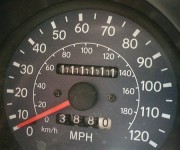Going Dutch: Drivers in Holland will have to pay a tax on how many miles they drive.Photo: Patrick PhippsGovernments are in dire need of infrastructure money: Backlogged repair bills run in the billions of dollars, and mounting traffic volumes are only making the problem worse. To add insult to injury, revenue from gasoline taxes is dropping around the world, whether that be from political inaction (bad!) or increasing fuel efficiency (good!). Either way, the problem has to be dealt with.
The Netherlands has begun a brave experiment to tax motorists not on how much gas they use, but how much they drive. This not only removes the troubled gas tax from the equation, it more accurately tracks how much people drive. There’s a catch: Even in environmentally conscious and politically liberal Holland, people have trouble stomaching a usage tax.
The recent political battle in the Netherlands over the tax should sound eerily familiar to Americans. The previous government had set all the wheels in motion to tax usage nationwide. But in 2010, a new government elected on a platform of “no new taxes” killed the plan — despite studies that predicted it would have lowered driving-related taxes for 60 to 70 percent of drivers.
For the most part, Europe has proven a fertile testing ground for innovative ways to reduce traffic — from London’s congestion charge to bike sharing programs to simply annoying drivers to the point that they opt for public transit. Part of the impetus comes from the European Union, which pressures governments to bring their countries’ greenhouse-gas emissions under control. Tracking and charging vehicle miles traveled (VMT) can be a powerful tool to reduce emissions from driving. On top of that, it also helps account for the wear and tear wrought by electric vehicles. The New York Times explains the Dutch system:
Hooked up to the Internet wirelessly and to GPS, the system tabulates a charge for each car trip by using a mileage-based formula that also takes account of a car’s fuel efficiency, the time of day and the route. (Driving on busier thoroughfares costs more than driving on less-traveled roads.) At the end of each month, the vehicle’s owner would receive a bill detailing times and costs of usage, not unlike a cellphone bill, although participants in the trial did not have to pay the charges.
One of the key components of the Dutch system is a display not unlike a taxi meter, which tallies the charge based on driving distance in real time. Such visual representations of money flying out of your pocket can be a powerful tool to change behavior.
The Netherlands is not alone in their experimentation; Germany and France will be installing GPS units in trucks to charge for distance. (Germany already monitors hours driven for long-haul truckers, so distance charging isn’t that much of a leap.) A few states in the U.S. have even explored the option, including Minnesota, Texas (of all places), and Oregon. The Oregon VMT tax is only directed at electric cars for now, since they don’t pay a gas tax. Drivers would report their mileage to the DMV (GPS reporting in an early trial was, um, controversial). Electric cars will serve as a test case, and in time the tax will be applied to all vehicles. While it makes sense on some levels to start with electric cars, it could also discourage people from buying zero-emissions vehicles. That’s too bad.
Though no country appears to be ready to adopt a VMT tax on a nationwide level, all signs indicate that we’ll be paying such a levy someday soon. With the gas tax (hopefully) on its way to obsolescence, we’ll need a new way to repair our roads and bridges. When done right, a VMT tax scheme could not only give our infrastructure funding a boost, it could also get us out from behind the wheel a bit more.




